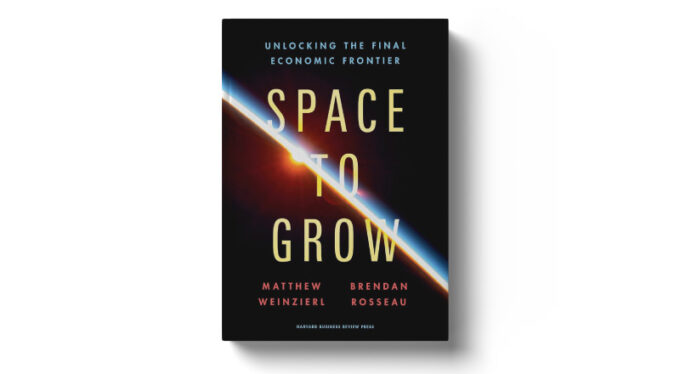Why your gut instinct matters more than ever in a data-driven world
Heather Cairns-Lee from IMD and leadership expert Eugene Sadler-Smith discuss why intuitive intelligence is a critical skill in a data-driven world....
March 28, 2025 • by Jim Pulcrano, Matthew C Weinzierl, Brendan Rosseau in I by IMD Book Club
Authors of Space to Grow, Matthew Weinzierl and Brendan Rosseau, tell IMD's Jim Pulcrano that one of the central aims of their book is to inspire industries, businesses and individuals...
We should make the business of space truly just a business.Author Brendan Rosseau
This is an extremely timely book, for many reasons. As Weinzierl succinctly puts it, “We need a holistic, economics-based framework for understanding the space sector, attracting new industries to it, and opening it up to a broader audience” – not least because the landscape is changing rapidly and how we “do” space is changing fundamentally.
Have someone in the C-suite whose job is to watch the sector and think about how they might make what’s happening valuable to them and their customers.Author Matthew Weinzierl

Arguably the main driver of change in the sector is the evolution of the relationship between the public and private sectors: whereas space exploration was once the sole preserve of government, NASA’s decision to open the field to the private sector greatly accelerated technology development and innovation.
Its decision was radical at the time and is a seminal model for public-private sector collaboration. Rather than attempting to control the space (pun semi-intended!), and realizing in the wake of the 1986 Columbia Space Shuttle and 2003 Challenger disasters that it needed help to resume its exploration activities, NASA opened the field to market forces – but it did so in a highly innovative and enlightened way, for three reasons.
First, it motivated the private sector by saying, “We don’t want to be your only customer – we want to be one customer among many, so make sure you’re designing something that will deliver value to potential commercial customers.” This was a basic principle that has since spread beyond NASA to the US Department of Defense and other government departments and agencies.
The second key aspect of NASA’s decision was to stress insight, rather than oversight, the traditional role of government. The space sector had been very centrally led, with the government telling commercial contractors exactly what they wanted them to build and how to build it. Now, NASA elected to share the unique insights garnered over decades of exploration with private sector actors to enable them to perform better.
Finally, the entry of commercial players to the field saw a switch from cost-plus contracting (the traditional model of public sector contracts with commercial suppliers) to fixed-price contracts. This incentivized private sector suppliers to minimize their costs and maximize their profit and was another spur to efficiency and competition.
Once you’ve succeeded in creating an economic engine that’s working well and expanding, there are no guarantees that what the market is producing is what society wants.
But while introducing market forces into what was an entirely public model had a huge impact in spurring innovation, bringing down costs, and directing the value of what’s created in space to “normal” terrestrial customers, it requires striking a balance between the public good and market imperatives. This, the authors say, can be broken down into three stages.
The first step is establishing the market. This is about creating truly robust markets and competition, and putting in place incentive structures that, in Brendan Rosseau’s memorable words, “make the business of space truly just a business.”
The second step, following the successful introduction of market forces, is refining the market. This is because marketization brings both good and bad news – you get innovation and efficiency on the one hand, but on the other, you get market failures, such as what economists call “the tragedy of the commons.” (This is where individuals with access to a public resource or “common” act in their own self-interest and ultimately deplete the resource in doing so.)
An important potential market failure in the space sector concerns financing. It would be extremely difficult for an individual actor to coordinate activities on their own to produce the necessary value; hence coordination between different financial actors, private and public, is necessary. You therefore need mechanisms to help address market failures.
The crucial third step is tempering the market, which the authors define as aligning it with society’s broader objectives. Once you’ve succeeded in creating an economic engine that’s working well and expanding, there are no guarantees that what the market is producing is what society wants. This concerns fundamental questions such as property rights, the rule of law, the equitable distribution of the gains that come from space, and who arbitrates these questions – who should decide what the goals are in space, and why?
This can easily be done by reading SpaceNews, Payload, or any of the other “amazing resources” out there that report on developments in the sector daily.
Given that Space to Grow aims to inspire businesses and individuals who traditionally do not see the realm that starts where our planet stops as a field they can play in, it begs the question of how they might think about industry entry. Here, Weinzierl has some elementary advice: imagine having someone in the C-suite whose job, as part of their portfolio, is to watch the sector and think about how the business might make what’s happening valuable to them and their customers.
This can easily be done by reading SpaceNews, Payload, or any of the other “amazing resources” out there that report on developments in the sector daily. “That would be my first recommendation,” Weinzierl adds, “just get in the habit of reading about this every day, and then you’ll spot the things that are of particular interest to you.”
In other words, watch this space!

Adjunct Professor of Entrepreneurship and Management
Jim Pulcrano is an IMD Adjunct Professor of Entrepreneurship and Management. His current projects include teaching in Lausanne, London and Silicon Valley, research on disruption, and various strategy, networking, customer-centricity, and innovation mandates with multinationals in Europe, Asia, and the US. At IMD, He is Director of the Venture Capital Asset Management (VCAM) program and teaches on the Executive MBA (EMBA), Orchestrating Winning Performance (OWP), and full-time MBA programs.

Joseph and Jacqueline Elbling Professor of Business Administration - Senior Associate Dean, Chair, MBA Program
Matt Weinzierl is Senior Associate Dean and Chair of the MBA Program at Harvard Business School, where he is the Joseph and Jacqueline Elbling Professor of Business Administration in the Business, Government, and the International Economy Unit, and a Research Associate at the National Bureau of Economic Research. Recently, he has launched a set of research projects focused on the commercialization of the space sector and its economic implications (www.economicsofspace.com). Prior to completing his PhD in economics at Harvard University in 2008, Weinzierl served as the Staff Economist for Macroeconomics on the President’s Council of Economic Advisers and worked in the New York office of McKinsey & Company.

Strategy Manager at Blue Origin
Brendan Rosseau is Strategy Manager at Blue Origin with a focus on orbital launch. He previously spent five years as an associate at Booz Allen Hamilton in Los Angeles supporting the US Space Force at Space Systems Command. He has extensive experience in space consulting, crafting space policy, aerospace startups, and astrophysical research. Rousseau is a teaching fellow and research associate at Harvard Business School, where he researches, develops, and teaches curriculum on the development of the space economy. He has an academic background in astronomy and economics that has emphasized independent research on the space industry with a focus on orbital launch. He is a co-author of Space to Grow: Unlocking the Final Economic Frontier (Harvard Business Publishing, 2025).
February 26, 2025 • by Heather Cairns-Lee, Eugene Sadler-Smith in I by IMD Book Club • 8 min read
Heather Cairns-Lee from IMD and leadership expert Eugene Sadler-Smith discuss why intuitive intelligence is a critical skill in a data-driven world....
January 17, 2025 • by Julia Binder, Knut Haanaes in I by IMD Book Club • 7 min read
IMD's Julia Binder and Knut Haanaes explore how aligning purpose with profit, fostering innovation, and building resilience, can help companies embed sustainability into business strategy....
November 30, 2024 • by Andrew Sharman , Susan Goldsworthy in I by IMD Book Club • 7 min read
This Book Club discussion explored actionable steps for individuals and companies to address the 'crisis of well-being'....
November 1, 2024 • by Gina Battye, Alexander Fleischmann in I by IMD Book Club • 8 min read
Gina Battye shares her advice on how to achieve long-term cultural change....
September 27, 2024 • by Shlomo Ben-Hur, Nikolas Kinley in I by IMD Book Club • 6 min read
Shlomo Ben-Hur and Nik Kinley reveal how our default instincts, shaped by childhood experiences, can help us to understand our leadership styles....
August 30, 2024 • by Julia Binder, Manuel Braun in I by IMD Book Club • 8 min read
Julia Binder and Manuel Braun delve into why a circular approach to business can help build more resilience and boost profitability....
July 19, 2024 • by Sarah E. Toms in I by IMD Book Club • 7 min read
Wharton professor Peter Fader unpacks the transformative power of customer centricity and why understanding customer lifetime value is crucial for business success....
June 21, 2024 • by Alexander Fleischmann in I by IMD Book Club • 8 min read
Corporate DE&I is not simply a question of fairness. Implemented successfully, it pays off for both the company and society in general. Paola Cecchi-Dimeglio, author of Diversity Dividend, discusses how it’s done...
May 31, 2024 • by Patrick Reinmoeller in I by IMD Book Club • 7 min read
The world is getting smarter. Rather than feel threatened, we need to learn how to become smarter to deal with it. Gerd Gigerenzer tells IMD’s Patrick Reinmoeller how it’s done ...
April 26, 2024 • by José Parra Moyano in I by IMD Book Club • 8 min read
AI holds incredible promise to improve virtually every aspect of our lives, but we can't ignore its risks, mishaps, and misuses, author Art Kleiner tells José Parra Moyano....
Explore first person business intelligence from top minds curated for a global executive audience